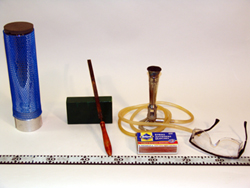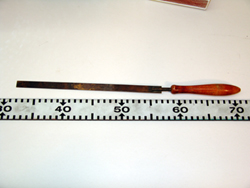|
Size: 1768
Comment:
|
Size: 1790
Comment: converted to 1.6 markup
|
| Deletions are marked like this. | Additions are marked like this. |
| Line 2: | Line 2: |
| = Bimetallic Strip, 4A30.10 = | = Bimetallic Strip, 4A30.10a = |
| Line 9: | Line 9: |
| (attachment photo showing the fully set up demonstration) | {{attachment:4A30-10a-01a.jpg}} |
| Line 17: | Line 17: |
| ||Bimetallic Strip||[:ThermoCabinetBayA3: TD, A3, Shelf #1]|| || | ||Bimetallic Strip||[[ThermoCabinetBayA3| TD, A3, Shelf #1]]|| || |
| Line 25: | Line 25: |
| 1. Install the burner. 1. Heat the bimetallic strip until it bends to one side. 1. Then, open the liquid nitrogen tank and put the bimetallic strip in the liquid nitrogen tank. 1. Take the bimetallic strip out of the liquid nitrogen tank and show students that it bends to the opposite side. |
Note: Make sure that one of the red & white gas cart are in placed and the gas hose is connected to the utility trench gas line. The gas cylinder that supplies the gas to utility trench gas line may or may not be connected/installed and should be inspected. 1. Make sure that you have all apparatuses in the table above. |
| Line 35: | Line 35: |
| The bimetallic strip consists of brass and stainless steel. Since brass has higher thermal expansion coefficient than stainless steel. When it is heated by the burner, it bends to the stainless steel side. On the other hand, placed in liquid nitrogen (77K) the strip bends in opposite which is to the brass side. | The bimetallic strip consists of brass and stainless steel. Since brass has higher thermal [[http://en.wikipedia.org/wiki/Coefficient_of_thermal_expansion|expansion coefficient]] than stainless steel. When it is heated by the burner, it bends to the stainless steel side. On the other hand, placed it in liquid nitrogen (77K) the strip bends in opposite which is to the brass side. |
| Line 38: | Line 38: |
| ||attachment other photos||attachment other photos|| ||attachment other photos||attachment other photos|| |
||{{attachment:4A30-10a-01i.jpg}}||{{attachment:4A30-10a-03-250.jpg}}|| |
| Line 43: | Line 43: |
| 1. [:www.hyperphysics.phy-astr.gsu.edu/hbase/thermo/bimetal.html: Hyperphysics] | 1. [[http://hyperphysics.phy-astr.gsu.edu/hbase/thermo/bimetal.html|Hyperphysics]] |
| Line 45: | Line 45: |
| [:ThermalProperties:Thermal Properties of Matter] | [[ThermalProperties|Thermal Properties of Matter]] |
| Line 47: | Line 47: |
| [:Demonstrations:Demonstrations] | [[Demonstrations]] |
| Line 49: | Line 49: |
| [:Instructional:Home] | [[Instructional|Home]] |
Bimetallic Strip, 4A30.10a
Location:
Cabinet: Thermodynamics Cabinet
Bay: (A3)
Shelf: #1

Description:
Insert description of apparatus, its component, what it is demonstrating.
Equipment |
Location |
ID Number |
|
|
|
Bimetallic Strip |
|
|
Burner |
location |
NA |
Liquid nitrogen |
location |
NA |
Safety grove and glasses |
location |
NA |
Setup:
Note: Make sure that one of the red & white gas cart are in placed and the gas hose is connected to the utility trench gas line. The gas cylinder that supplies the gas to utility trench gas line may or may not be connected/installed and should be inspected.
- Make sure that you have all apparatuses in the table above.
Cautions, Warnings, or Safety Concerns:
- Beware of the burner and the liquid nitrogen.
Demonstration:
The bimetallic strip consists of brass and stainless steel. Since brass has higher thermal expansion coefficient than stainless steel. When it is heated by the burner, it bends to the stainless steel side. On the other hand, placed it in liquid nitrogen (77K) the strip bends in opposite which is to the brass side.
|
|
References:

